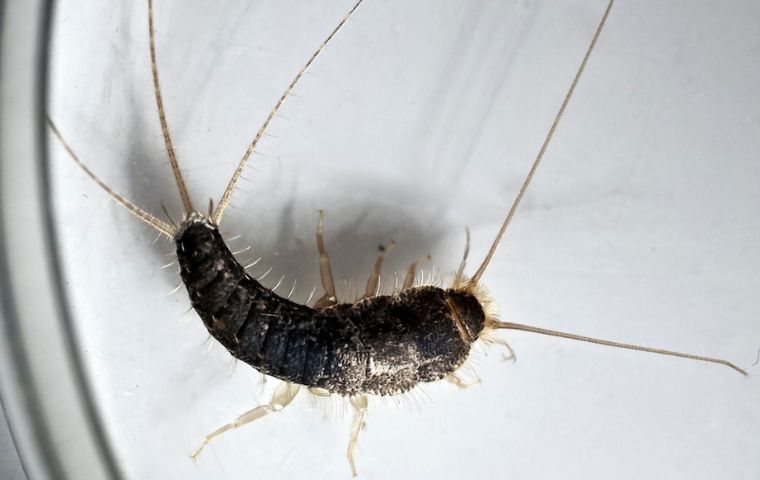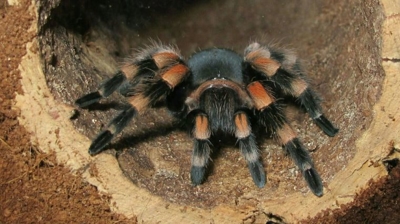
Firebrats
What Are Firebrats?
Firebrats, scientifically known as Thermobia domestica, are small, wingless insects belonging to the order Zygentoma. These fascinating arthropods are commonly referred to as firebrats due to their ability to thrive in warm, dry environments, resembling the conditions around a fire. Here is an overview of firebrats:
Are Firebrats Harmful?
Firebrats (Thermobia domestica) are small, wingless insects that resemble silverfish, but they thrive in warmer, more humid environments, often near heat sources. While they are generally not considered as damaging as some other pests, they can still be harmful in several ways:
- Damage to Property and Belongings: Firebrats are known to feed on organic materials, including starches, sugars, and even some fabrics. This means they can cause damage to a variety of household items, such as books, wallpaper, clothing, and pantry items. Over time, their feeding can lead to noticeable damage or degradation of these materials.
- Contamination of Food: Although firebrats primarily feed on non-food materials, they are often found in areas where food is stored, like pantries or kitchens. Their presence could lead to contamination of food, as they may crawl across edible items, leaving behind feces, scales, or saliva. This could pose a risk to food safety and hygiene.
- Attracting Other Pests: Firebrats are sometimes found in conjunction with other pests, such as cockroaches and termites. Their presence in the home could indicate an environment that is conducive to other, more dangerous pests, making their detection a potential warning sign.
- Allergic Reactions: Though not a common issue, firebrats can sometimes trigger allergic reactions in sensitive individuals. The shedding of their scales or feces may contribute to dust and allergens in the environment, particularly in areas where firebrats are abundant.
- Presence as a Sign of Poor Sanitation: A firebrat infestation can indicate problems with moisture and poor sanitation in the home. Their preference for warm, humid environments, such as basements, attics, or areas near heating ducts, may suggest moisture issues that could also promote the growth of mold or mildew. This can contribute to a decline in air quality and potentially cause structural problems over time if the moisture issue isn't addressed.
While firebrats do not usually pose a direct health threat, their presence can be a nuisance and may indicate underlying issues with your home’s condition, which could lead to more serious concerns if left unchecked.
Firebrat Appearance
Firebrats, scientifically known as Thermobia domestica, are close relatives of and look similar to silverfish, but have distinct physical characteristics that set them apart from silverfish and other insects. Here is a detailed description of their appearance:
- Size: Firebrats are relatively small insects, typically measuring between 6 to 12 millimeters (0.24 to 0.47 inches) in length.
- Body Shape: They have an elongated and flattened body, which gives them a somewhat carrot-shaped appearance.
- Color: The body of a firebrat is covered in small, silvery scales, which give it a shiny, metallic appearance. However, the scales can also appear mottled with dark patches, depending on the individual and its age.
- Antennae: Firebrats have long, slender antennae that are nearly as long as their body. These antennae are one of their distinguishing features and are used for sensory perception.
- Eyes: They have small, compound eyes on the sides of their head, which are not very prominent due to their nocturnal nature.
- Legs: Firebrats have six legs, which are relatively short and sturdy, aiding in their quick movements.
- Wings: One of the most notable characteristics of firebrats is that they are wingless. Unlike some other insects in the order Zygentoma, firebrats do not possess wings. This lack of wings distinguishes them from winged insects.
Firebrats are small, elongated insects with a flattened body covered in silvery scales. Their long antennae and wingless appearance make them easily recognizable. These physical adaptations are well-suited for their habitat and lifestyle, which typically involves living in warm, dry indoor environments.
Firebrat Habitat
Firebrats (Thermobia domestica) are commonly found in indoor environments, particularly in places where they can thrive in warm and dry conditions. Here is a detailed description of the typical locations where firebrats are commonly found:
- Homes: Firebrats are often encountered in homes, especially in areas with elevated temperatures. They may be found in kitchens, near ovens, stoves, or hot water heaters, as these appliances generate warmth. They are also known to inhabit wall voids, behind baseboards, and in crawl spaces.
- Commercial Buildings: Firebrats can infest commercial structures such as restaurants, bakeries, and food storage facilities due to the availability of starchy materials like flour and food crumbs.
- Warehouses: In warehouses and storage facilities, firebrats can be found among stored goods and cardboard boxes, as they feed on paper products and cardboard.
- Libraries and Museums: These insects can be a nuisance in libraries and museums, where they may damage books, paper documents, and artifacts. They are attracted to the cellulose and glue found in these materials.
- Bathrooms: Firebrats may inhabit bathrooms, especially if there are warm pipes or heating ducts nearby. They can be found in hidden cracks and crevices.
- Basements: In homes with warm and humid basements, firebrats may take up residence in dark corners and crevices.
- Boiler Rooms: The warm and dry conditions of boiler rooms make them attractive to firebrats. They may be found near heating systems or pipes.
- Greenhouses: In some cases, firebrats can infest greenhouses, as the warm and humid environment can provide suitable conditions.
- Restaurants and Bakeries: Commercial kitchens and food preparation areas provide an abundance of food crumbs and starchy materials, making them attractive to firebrats.
- Libraries and Archives: Firebrats are known to damage books, manuscripts, and historical documents in libraries and archives. They can be found in bookshelves and storage areas.
Firebrats thrive in environments with temperatures ranging from 90°F (32°C) to 110°F (43°C) and prefer dry conditions. They are nocturnal, which means they are most active during the night when the environment is cooler. Effective pest control measures may be necessary if firebrats become a nuisance in these locations, especially when they start causing damage to stored items or structural materials.
Firebrat Diet
Firebrats (Thermobia domestica) are opportunistic feeders and consume a variety of organic materials. They are particularly attracted to substances rich in carbohydrates. Here is a more detailed description of what firebrats eat:
- Starchy Materials: Firebrats have a strong preference for starchy materials. They feed on items such as paper, cardboard, and book bindings, as these materials contain cellulose and other carbohydrates. In homes and libraries, they are known to damage books, paper documents, wallpaper, and cardboard boxes.
- Glue: Firebrats are drawn to glue, especially the types used in bookbinding and wallpaper adhesive. They may nibble on the glue found in books or the glue used to attach wallpaper to walls.
- Food Crumbs: In kitchens and areas where food is prepared or stored, firebrats can feed on food crumbs and particles. They are attracted to spilled grains, cereal, flour, and other pantry items.
- Fabric: Although not their primary source of nutrition, firebrats may occasionally feed on fabrics, particularly those stained with food or other organic substances. They are not as destructive to fabrics as some other pests.
- Dead Insects: Firebrats are scavengers and may consume dead insects that they come across in their environment.
- Mold and Fungus: In humid conditions, firebrats may also feed on mold and fungus growing on surfaces, as these can be sources of moisture and nutrients.
- Pet Food: If pet food is left exposed in areas where firebrats are present, they may nibble on it, as it contains carbohydrates.
- Hair and Dandruff: In some cases, firebrats have been observed feeding on human hair and dandruff, although this is not a common food source for them.
Firebrats are primarily active at night, and their feeding habits are influenced by their nocturnal behavior. They are more likely to forage for food in the dark when the environment is cooler and less populated. Effective pest control measures, such as eliminating food sources and maintaining a clean and dry environment, can help prevent infestations of firebrats, especially in areas where they can cause damage to valuable items.

Firebrat Life Cycle
The life cycle of a firebrat (Thermobia domestica) consists of several stages, from egg to nymph to adult. These insects undergo gradual metamorphosis, which means that the nymphs resemble miniature adults but lack wings and reproductive organs. Here's a more detailed overview of the firebrat life cycle:
- Egg Stage: The life cycle begins when adult female firebrats lay eggs in concealed and sheltered locations, such as cracks, crevices, and hidden areas of their habitat. The eggs are small, oval-shaped, and typically white or pale yellow. The exact number of eggs laid by a female can vary but often ranges from a few dozen to several hundred. The duration of the egg stage depends on environmental conditions, primarily temperature and humidity. It can last anywhere from a few weeks to a few months.
- Nymph Stage: Once the eggs hatch, they give rise to nymphs. Firebrat nymphs closely resemble miniature versions of adult firebrats but are smaller and lack wings. Nymphs go through a series of molts as they grow. Each molt results in a slightly larger nymph with more developed features. The number of molts varies among individuals, but it typically ranges from 7 to 13 molts before reaching adulthood. The exact number of molts can be influenced by factors such as temperature and food availability. During the nymph stage, firebrats are active, feeding on a variety of organic materials, particularly carbohydrates like paper and glue. They are primarily nocturnal, and their activity is highest during the night.
- Adult Stage: After the final molt, the firebrat reaches adulthood. Adult firebrats have a more elongated and tapered appearance compared to nymphs. Unlike nymphs, adult firebrats have well-developed reproductive organs, but they remain wingless throughout their entire life. Firebrats are capable of mating shortly after becoming adults. They reproduce by laying eggs, and the cycle continues.
- Reproduction: Adult female firebrats can lay eggs throughout their lifespan, with the number of eggs laid varying depending on factors like temperature and food availability. Mating typically occurs when a male locates a receptive female, and they engage in a courtship ritual before mating. After mating, females seek out suitable egg-laying sites to deposit their eggs, often in hidden and protected areas.
The entire life cycle of a firebrat, from egg to adult, can take several months to a few years, with environmental conditions playing a significant role in the duration of each stage. Firebrats are known for their ability to adapt to warm and dry environments, which allows them to thrive in indoor locations where they can find suitable food sources and shelter.

Hear From Our Happy Customers
-
"Exceeds Expectations"
I can’t say enough positive things about this company... The tech that came out, Jarvis went above and beyond my expectations. Thank you guys, I will continue using your services.
- Jake M. -
"Very Knowledgeable"
The tech that arrived was courteous, professional, and very knowledgeable. He was Great.
- Uerial I. -
"Fantastic & Patient"
Jarvis was fantastic and patient. He answered my questions with an in-depth explanation and addressed all of my areas of concern. Would love for him to be my assigned tech going forward. Well done!
- Yonnette M. -
"Wonderful Service"
Wonderful service. Jarvis is great. Took care of everything I needed. Thank you!
- Henry P. -
"Professional & Considerate"
I’m pleased with Miche services. Jarvis came today. Professional and considerate. Thank you!
- Judy B. -
"Great Communication"
Tech was on time, communication was great, and he accommodated my needs.
- Alonzo W.



